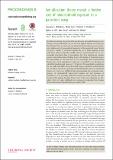Files in this item
Sex allocation theory reveals a hidden cost of neonicotinoid exposure in a parasitoid wasp
Item metadata
| dc.contributor.author | Whitehorn, Penelope R. | |
| dc.contributor.author | Cook, Nicola | |
| dc.contributor.author | Blackburn, Charlotte V. | |
| dc.contributor.author | Gill, Sophie M. | |
| dc.contributor.author | Green, Jade | |
| dc.contributor.author | Shuker, David M. | |
| dc.date.accessioned | 2015-09-16T10:10:20Z | |
| dc.date.available | 2015-09-16T10:10:20Z | |
| dc.date.issued | 2015-05 | |
| dc.identifier | 207740317 | |
| dc.identifier | 7a476c76-01c7-4942-9d75-d3c036be0531 | |
| dc.identifier | 000357460400010 | |
| dc.identifier | 84928905803 | |
| dc.identifier | 000357460400010 | |
| dc.identifier.citation | Whitehorn , P R , Cook , N , Blackburn , C V , Gill , S M , Green , J & Shuker , D M 2015 , ' Sex allocation theory reveals a hidden cost of neonicotinoid exposure in a parasitoid wasp ' , Proceedings of the Royal Society B: Biological Sciences , vol. 282 , no. 1807 , 20150389 . https://doi.org/10.1098/rspb.2015.0389 | en |
| dc.identifier.issn | 0962-8452 | |
| dc.identifier.other | ORCID: /0000-0003-4462-0116/work/60427609 | |
| dc.identifier.uri | https://hdl.handle.net/10023/7480 | |
| dc.description | P.R.W. was funded by the University of Stirling, C.V.B. and S.M.G. were funded by Nuffield Research Placements and N.C., J.G. and D.M.S. were funded by NERC (NE/J024481/1). | en |
| dc.description.abstract | Sex allocation theory has proved to be one the most successful theories in evolutionary ecology. However, its role in more applied aspects of ecology has been limited. Here we show how sex allocation theory helps uncover an otherwise hidden cost of neonicotinoid exposure in the parasitoid wasp Nasonia vitripennis. Female N. vitripennis allocate the sex of their offspring in line with Local Mate Competition (LMC) theory. Neonicotinoids are an economically important class of insecticides, but their deployment remains controversial, with evidence linking them to the decline of beneficial species. We demonstrate for the first time to our knowledge, that neonicotinoids disrupt the crucial reproductive behaviour of facultative sex allocation at sub-lethal, field-relevant doses in N. vitripennis. The quantitative predictions we can make from LMC theory show that females exposed to neonicotinoids are less able to allocate sex optimally and that this failure imposes a significant fitness cost. Our work highlights that understanding the ecological consequences of neonicotinoid deployment requires not just measures of mortality or even fecundity reduction among non-target species, but also measures that capture broader fitness costs, in this case offspring sex allocation. Our work also highlights new avenues for exploring how females obtain information when allocating sex under LMC. | |
| dc.format.extent | 6 | |
| dc.format.extent | 597906 | |
| dc.language.iso | eng | |
| dc.relation.ispartof | Proceedings of the Royal Society B: Biological Sciences | en |
| dc.subject | Systemic insecticide | en |
| dc.subject | Beneficial insects | en |
| dc.subject | Sex ratio | en |
| dc.subject | QH301 Biology | en |
| dc.subject | DAS | en |
| dc.subject.lcc | QH301 | en |
| dc.title | Sex allocation theory reveals a hidden cost of neonicotinoid exposure in a parasitoid wasp | en |
| dc.type | Journal article | en |
| dc.contributor.sponsor | NERC | en |
| dc.contributor.institution | University of St Andrews. School of Biology | en |
| dc.contributor.institution | University of St Andrews. Centre for Biological Diversity | en |
| dc.contributor.institution | University of St Andrews. Scottish Oceans Institute | en |
| dc.contributor.institution | University of St Andrews. Institute of Behavioural and Neural Sciences | en |
| dc.identifier.doi | 10.1098/rspb.2015.0389 | |
| dc.description.status | Peer reviewed | en |
| dc.identifier.grantnumber | NE/J024481/1 | en |
This item appears in the following Collection(s)
Items in the St Andrews Research Repository are protected by copyright, with all rights reserved, unless otherwise indicated.

